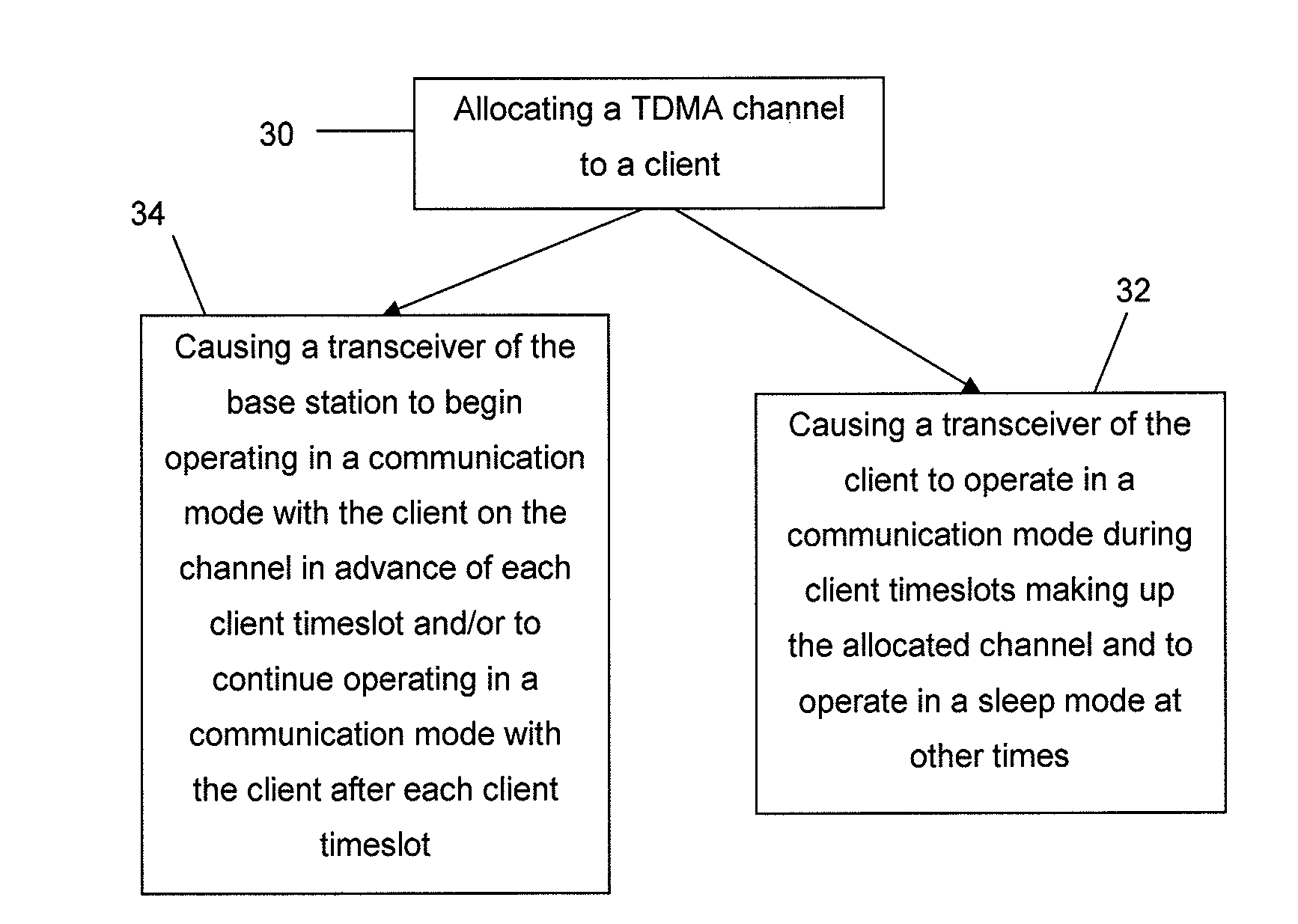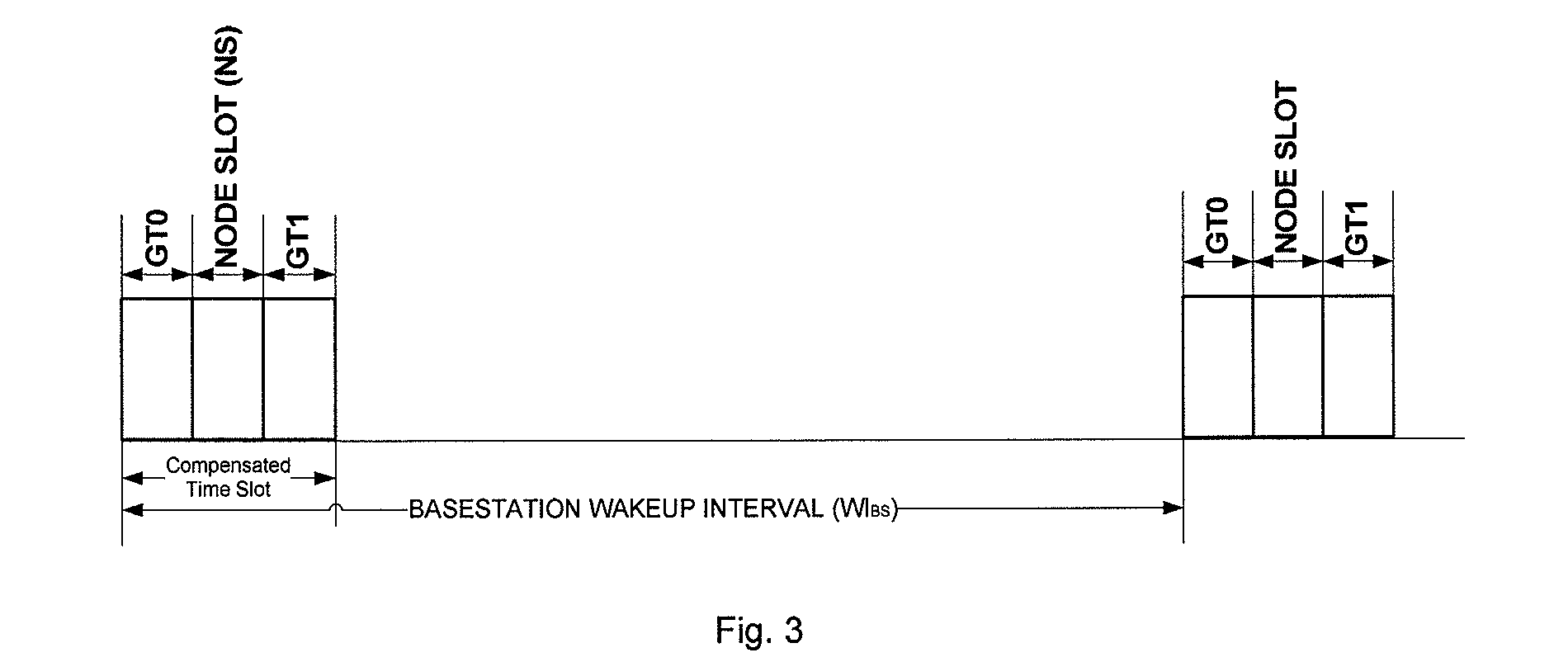A tdma-based communication method and system
a communication method and time division technology, applied in power management, synchronisation arrangement, transmission, etc., can solve the problems of wasting time, consuming power, and reducing the precision of clocks that can be used by clients
- Summary
- Abstract
- Description
- Claims
- Application Information
AI Technical Summary
Benefits of technology
Problems solved by technology
Method used
Image
Examples
example 1
DSN>>DCN
[0042]For comparison, we will calculate the respective duty cycles for a client A and a base station 12 communicating with just that client A, in accordance with the above method, assuming that base station 12 is active for the whole of the compensated base timeslot (NSBS), while the client A is only active for the client timeslot (NS).
[0043]In this example, we will assume that the client A has a timer precision of DSN=1% and the base station 12 has a timer precision of DCN=0.001% (i.e. DSN>>DCN as is likely to be the case where the client employs a cheap inaccurate clock and the base station employs a more expensive, more precise clock). In this case, we can therefore assume that DWC≈DSN.
[0044]In addition, we will assume that the client A is configured to sleep for WI=2 minutes and to communicate for a maximum of NS=100 ms when it wakes up. We can therefore calculate the base station 12 wakeup interval WIBS, the guard times GT0 and GT1, and the compensated base timeslot NS...
example 2
DSN=DCN
[0049]In a further embodiment of the present invention we can consider the case where the client A has a timer precision of DSN=0.001% and the base station 12 also has a timer precision of DCN=0.001% (i.e. DSN=DCN as is the case where the same clocks are employed by the client and the base station).
[0050]In this case, the worst case clock offset DWC=(DSN+DCN)=0.002%.
[0051]In addition, we will assume that the client A is configured to sleep for WI=2 hours and to communicate for a maximum of NS=100 ms when it wakes up. We can therefore calculate the base station 12 wakeup interval WIBS, the guard times GT0 and GT1, and the compensated base timeslot NSBS as follows:
WIBS=2*3600*(100−0.002) / 100=7199.856 seconds
GT0=GT1=2*3600*0.002 / 100=0.144 seconds
NSBS>=0.144+0.1+0.1*(0.002 / 100)+0.144≈0.4 seconds
[0052]Consequently, for this one client A, the duty cycle DCCN of the base station 12 is:
DCCNBS / WIBS=0.4 / 7199.856≈0.0056%
[0053]Similarly, the worst case duty cycle DCSN for the client A i...
example 3
[0078]A node has a clock resolution of 500 ppm, but wants a duty cycle equivalent to 100 ppm i.e. 5 times its capability. Let us imagine that it is trying to join a hub that has 40×2 ms slots, with 10 slots set aside for random access protocols (e.g. RAP2). Further, the node wants a wake-up interval of 20 seconds which is communicated as 250 multi-periodic (m=250). So how does the hub support this?
[0079]The maximum drift for the node during the wake-up interval is ˜500 ppm in 20 secs=2×10 ms=20 ms=10 slots in total (or 5 slots before and after the node's allocation).
[0080]With the proposed mechanism, if the hub assigns the node slot 25, it needs to set aside slots 20 to 30 in the node's wake-up superframe. This makes it possible for 1 periodic nodes like ECG streaming nodes to co-exist with this much lower power, longer term sensor nodes.
PUM
 Login to View More
Login to View More Abstract
Description
Claims
Application Information
 Login to View More
Login to View More - R&D
- Intellectual Property
- Life Sciences
- Materials
- Tech Scout
- Unparalleled Data Quality
- Higher Quality Content
- 60% Fewer Hallucinations
Browse by: Latest US Patents, China's latest patents, Technical Efficacy Thesaurus, Application Domain, Technology Topic, Popular Technical Reports.
© 2025 PatSnap. All rights reserved.Legal|Privacy policy|Modern Slavery Act Transparency Statement|Sitemap|About US| Contact US: help@patsnap.com



